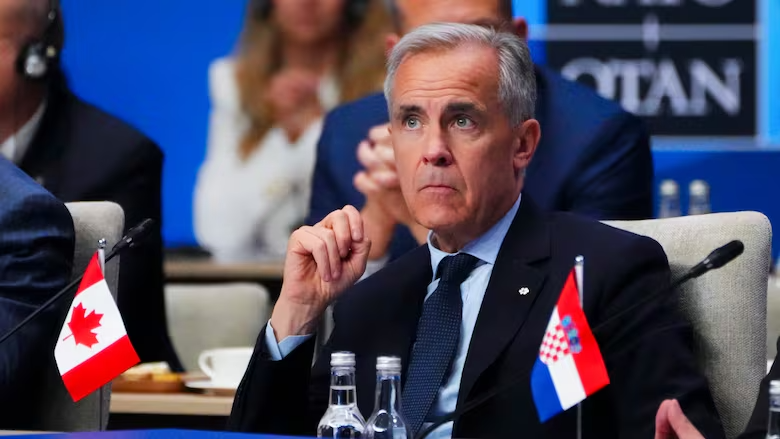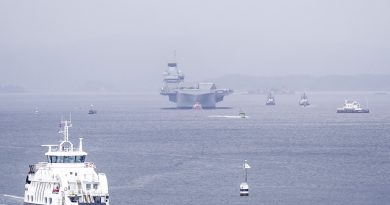Canada promises to spend 5% of GDP on defence by 2035 in pact with NATO leaders

Now there’s pressure on Trump to commit to self-defence clause in exchange for funding boost
NATO leaders — including Canada — have approved a plan to dramatically increase defence spending across the Western alliance to five per cent of gross domestic product over the next decade, a decision that has given U.S. President Donald Trump a significant policy victory.
They gathered behind closed doors in the Netherlands on Wednesday, where the final details and potential grievances were hashed out.
“As the global landscape shifts, the collective security created by the [NATO] alliance remains the strongest and most effective way of protecting Canadian sovereignty and protecting the security of Canadians,” Prime Minister Mark Carney said in The Hague on Wednesday.
“With our allies we must ensure that Canada remains strong, unified and ready to confront the threats not just of today but of tomorrow.”
Trump says he will back mutual NATO defence clause
Members of the alliance, however, were expecting something in return — a fervent commitment from Trump on NATO’s self-defence clause, Article 5.
Senior Canadian officials, speaking on background following the meeting, said the allies seemed comfortable with the U.S. president’s reassurances, despite his equivocating in public about whether Washington would come to the defence of its allies in a crisis.
On his way to the summit, Trump was asked whether he supported Article 5, and he responded that the self-defence clause has many definitions. In fact, the language is quite clear — saying an attack on one member is considered an attack on all NATO allies.
After the announcement, Trump was asked again if he would now stand behind Article 5, given that NATO leaders have agreed to boost military funding.
“I stand with it, that’s why I’m here, that’s why I’m here,” Trump said. “If I didn’t stand with it, I wouldn’t be here.”
NATO Secretary General Mark Rutte opened the shortened summit by praising Trump for leading the charge on increased defence spending.
“For too long, one ally, the United States, carried too much of the burden of that commitment — and that changes today,” Rutte said. “President Trump, dear Donald, you made this change possible. Your leadership on this has already produced one trillion dollars in extra spending from European allies since 2016. And the decisions today will produce trillions more for our common defence.”
A compromise for allies
Carney said the move to five per cent of gross domestic product — 3.5 per cent for core military spending and 1.5 per cent for defence-related infrastructure — will take place over the next 10 years, but will be reviewed in 2029 to ensure those targets still align with the threats Canada is facing.
That is a compromise for allies — including Canada — who are finding such a big increase hard to swallow.
Carney revealed on Monday during an interview with CNN that meeting the new defence spending goal of five per cent of GDP would cost the federal treasury $150 billion per year.
That translates into roughly $107 billion in direct military spending, with the rest earmarked for defence infrastructure, such as ports, bases and airfields.
When asked what sacrifices Canadians will have to make to meet this funding commitment, Carney said there will be trade-offs — but he noted certain sacrifices are already being made.
“The people making sacrifices have been the men and women of the Canadian Armed Forces, because they have not been paid to reflect what we are asking them to do, they haven’t been operating with the right equipment in many cases,” he said.
Canada is making up for those shortcomings by investing in Canada’s defence budget this year, but in five or 10 years, if the threats to Canada’s security continue to increase, Carney acknowledged Canadians may have to make compromises when it comes to public spending.
Those trade-offs, the prime minister said, would likely happen toward the end of the decade and into the next and if they do, he said there would be “a very clear and open conversation” about where people are willing to compromise.
Controlling costs, reaping benefits
The prime minister said he will try to control the increase in defence spending by proceeding carefully. Boosting military and spending significantly in the short term, Carney said, could create “choke points” where demand outstrips supply and lead to rising prices that would eat up that increased spending.
Carney said his government will therefore not dramatically increase defence spending out of the gates, but will do it at a “measured pace” and in concert with European allies.
The prime minister also said he expects the announcement that NATO members plan to increase spending across the board in the next decade will have a significant deterrence effect on those wishing to threaten the alliance.
“The deterrence element of NATO has just gone up substantially, and it’s crucial, and we would really feel it if we went in the other direction,” Carney said.
What will Canadians think?
Canada has not seen this kind of massive military spending increase since the Second World War or Korean War, says defence expert Dave Perry of the Canadian Global Affairs Institute.
Whether the Canadian public is prepared for it is another matter.
Public opinion had been overwhelmingly supportive of hitting the old two per cent NATO target.
And Perry said Canadians will have to try and look past the fact that this is Trump’s deal.
“This is finally taking off the table what has been an enduring, serious irritant with the United States government of multiple administrations,” he said. “I had an American former State Department official complaining last night … ‘We asked nicely for years and nobody did anything — until Trump stopped asking nicely.'”
Diversifying Canada’s defence supply chain
In March, Canada announced it is looking at alternatives to the purchase of 88 F-35 jets that Canada is buying from U.S. defence giant Lockheed Martin.
On Wednesday, Carney said he has used his trip to speak with allies about the possibility of buying European fighter jets and that a decision on that could be coming soon. The prime minister said he also discussed the possible purchase of European-made submarines.
“The review of the F-35 we expect to complete by the end of the summer. We’ll take all the time necessary,” he said.
Carney said examining whether Canada would buy European-made submarines has a longer timeline, at least until 2027, and a decision on that file may not be taken until 2028.
“It’s a big procurement process and there’s multiple steps, but there’s lots of interest in helping us with that,” Carney said.
Related stories from around the North:
Canada: Carney travelling to Europe for security, defence talks with EU, NATO, The Canadian Press
Denmark: Denmark approves US military bases on Danish soil as Trump eyes Greenland, The Associated Press
Greenland: Europeans step up Arctic diplomacy amid U.S. and global pressure, Eye on the Arctic
Finland: Finland hails plan for allies to join NATO land forces in North, The Independent Barents Observer
Iceland: Iceland’s FM announces defence review, calls revamped security policy ‘urgent’, Eye on the Arctic
Norway: Norway confirms it will spend 5% of GDP on defence, Reuters
Russia: Drone attack on Russian warplanes, including in Arctic, serious blow to strategic arsenal, The Associated Press
Sweden: Nordic-Baltic region joins forces around Sweden’s CV90, The Independent Barents Observer
United States: White House releases U.S. Arctic strategy implementation plan, Eye on the Arctic



